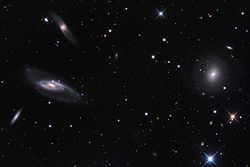
NGC 536 is a barred spiral galaxy located in the constellation Andromeda. It is located at a distance of circa 200 million light-years from Earth, which, given its apparent dimensions, means that NGC 536 is about 180,000 light years across. It was discovered by William Herschel on September 13, 1784. It is a member of Hickson Compact Group 10, which also includes the galaxies NGC 529, NGC 531, and NGC 542. It belongs to the Perseus–Pisces Supercluster.

NGC 820 is a spiral galaxy located in the constellation Aries about 210 million light-years from the Milky Way. It was discovered by British astronomer John Herschel in 1828.

NGC 830 is a barred lenticular galaxy in the constellation Cetus. It is estimated to be about 170 million light-years from the Milky Way and has a diameter of approximately 70,000 light years.

NGC 900 is a lenticular galaxy located in the constellation Aries about 430 million light-years from the Milky Way. It was discovered by the German astronomer Albert Marth in 1864.

NGC 910 is an elliptical galaxy in the constellation of Andromeda. NGC 910 was discovered on October 17, 1786 by the German-British astronomer William Herschel. It is the brightest galaxy in the cluster Abell 347.
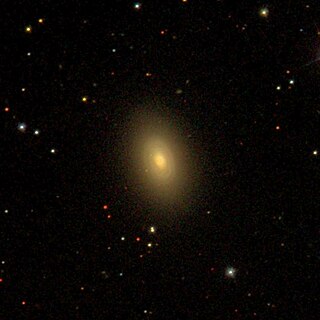
NGC 940 is a lenticular galaxy in the constellation Triangulum. It is estimated to be 222 million light-years from the Milky Way and has a diameter of approximately 80,000 ly. NGC 940 was discovered by Heinrich d'Arrest.

NGC 980 is a lenticular galaxy located in the constellation Andromeda about 256 million light years from the Milky Way. It was discovered by the German - British astronomer William Herschel in 1786.

NGC 530, also known as IC 106, is a lenticular galaxy in the constellation Cetus. It is approximately 226 million light years from the Milky Way and has a diameter of around 100,000 light years. The object was discovered on November 20, 1886 by the American astronomer Lewis A. Swift, who listed it as NGC 530, and rediscovered on November 16, 1887 by Guillaume Bigourdan, who listed it as IC 106.

NGC 904 is an elliptical galaxy in the constellation Aries. It is estimated to be 244 million light years from the Milky Way and has a diameter of approximately 85,000 ly. NGC 904 was discovered on 13 December 1884 by the astronomer Edouard Stephan.
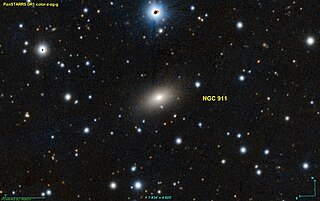
NGC 911 is an elliptical galaxy located in the constellation Andromeda about 258 million light years from the Milky Way. It was discovered by French astronomer Édouard Stephan in 1878. It is a member of the galaxy cluster Abell 347.

NGC 912 is a compact lenticular galaxy located in the constellation Andromeda about 197 million light years from the Milky Way. It was discovered by French astronomer Édouard Stephan in 1878.

NGC 913 is a lenticular galaxy located in the constellation Andromeda about 224 million light years from the Milky Way. It was discovered by French astronomer Édouard Stephan in 1878.

NGC 802 is a lenticular galaxy in the constellation Hydrus. It is about 68 million light-years from the Milky Way and has a diameter of about 20,000 light years. NGC 802 was discovered on November 2, 1834 by the British astronomer John Herschel.

NGC 996 is an elliptical galaxy of the Hubble type E0 in the constellation Andromeda. It is estimated to be 210 million light years from the Milky Way and has a diameter of approximately 75,000 ly. The supernova SN 1996bq occurred in this galaxy. NGC 996 was discovered on December 7, 1871 by astronomer Édouard Stephan.
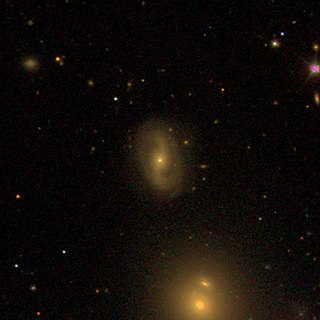
NGC 998 is a spiral galaxy in the constellation Cetus. It is estimated to be 294 million light years from the Milky Way and has a diameter of approximately 90,000 ly. Together with NGC 997, it forms a gravitationally bound pair of galaxies. NGC 998 was discovered by astronomer Albert Marth on 10 November 1863 using a 48-inch telescope.
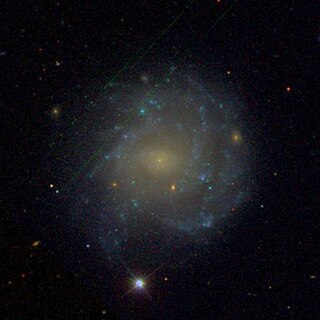
NGC 991 is an intermediate spiral galaxy the constellation Cetus. This galaxy was discovered by astronomer William Herschel in 1785.

NGC 531 is a barred spiral galaxy in the constellation Andromeda with a visual magnitude of 10.51. It is a distance of 65.7 Mpc from the Sun. It is a member of the Hickson Compact Group HCG 10, and is interacting with the other members of the group.

NGC 938 is an elliptical galaxy located in the constellation Aries, approximately 184 million light years from the Milky Way. It was discovered by the Prussian astronomer Heinrich d'Arrest in 1863.
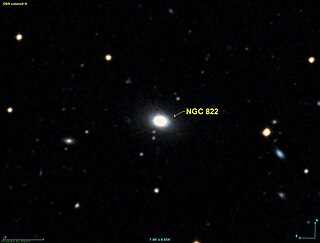
NGC 822 is an elliptical galaxy in the constellation Phoenix. It is estimated to be about 233 million light-years from the Milky Way and has a diameter of approximately 80,000 light-years. NGC 822 was discovered on September 5, 1834, by astronomer John Herschel.

NGC 767 is a barred spiral galaxy located in the constellation Cetus about 241 million light years from the Milky Way. It was discovered by the American astronomer Francis Leavenworth in 1886.
